Boggs S. Principles of Sedimentology and Stratigraphy
Подождите немного. Документ загружается.

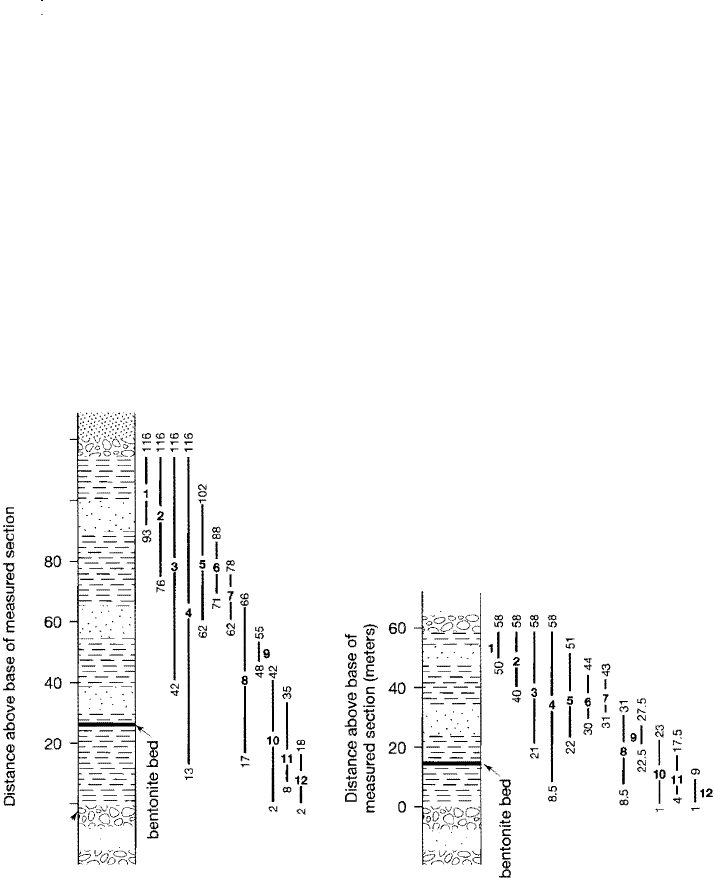
14.7 Biocorrelation 507
and last appearances of the same species in another section. This method is now
widely used by stratigraphers for detailed time-stratigraphic correlation between
stragraphic sections, particularly local sections.
Shaw's method, as further elaborated by Miller (1977), involves first select
ing a single stratigraphic section as a reference section to which other sections can
be compared and correlated. This reference section should be the thickest section
available, should be free of faulting or other structural complications, and should
contain a large and varied fossil content. The reference section is measured and
sampled as completely as possible, and the first and last appearances of all species
are documented in terms of their positions in the stratigraphic section above an ar
bitrarily chosen reference point, that is, number of meters above the base of the
measured section (Fig. 14.12) . The species ranges recorded by the first and last ap
pearances in this local reference section may not be the true (total) ranges for all of
the species; however, is fact does not preclude using them to help establish cor
relation, as we shall see. A second stratigraphic section is then chosen to be com
pared with the reference section, and the first and last appearances of the same
species, and any other species, are determined in this section.
From o such stratigraphic sections (Fig. 14.12), a graph is constructed in
which
distance above the base of the reference section, say section A, is indicated
on the vertical axis and distance above the base of the second measured section,
section B, is plotted on the horizontal axis (Fig. 14.13). The rst and last appear
ances of each species in the reference section can then be plotted against the first
and last appearances of the same species in the second measured section. In
Figure 14.12, for example, Species 3 first appears in reference Section A at 42 m
above the base of the section and in measured Section B at about 21 m above the
base. A single point can be plotted on the graph to represent these values. Similar
ly, additional points are plotted to represent the first and last appearances of all
the species in the two sections. The dashed lines Figure 14.13 illustrate how the
points are plotted. This procedure yields a series of points that tend to cluster
around a straight ne, the line of correlation in Figure 14.13. This line can be drawn
visually to yield a "best-fit" line, or it can be drawn by use of statistical regression
120
100
0
I
Base of
1
measured
section
Measured
Section A
Measured
Section B
Fire 14.12
Two stratigraphic sections
with ranges of fossil species
(Species 1 through 12)
graphed in meters above
the base of the section.
Sections A and B contain
identical fossils with identi
cal time spans; however,
Section B represents only
half the rate of sediment
accumulation. Use of these
fossil ranges in A. B. Shaw's
(1 964) graphic correlation
method is illustrated in
Figure 14.18. [After Eicher,
D. L., Geologic time, 2nd
ed., Prentice-Hall, Fig. 5.8,
p. 112; data from Ericson
and Wollin, 1968.]
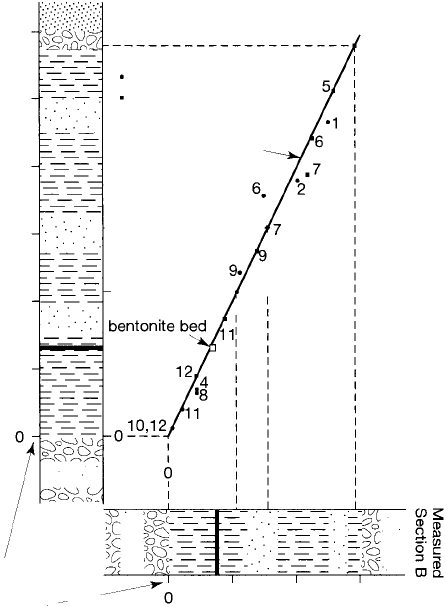
508
Chapter 14 I Biostratigraphy
120
100
¥
80
£
60
>
0
40
c
i
0
20
Figure 14.13
Measu
r
ed
Se
cti
o
n
A
Bottom of
r
ange zo
ne
Top of
r
ange zo
n
e
Li
n
e of c
o
rr
elatio
n
8.
. ___________
5
__
7
I
I
I
I
---------1
·10
1
1 ,2,3,4
Illustration of the graphic correlation method using the
data shown in Figure 14.1 2. The dashed lines illustrate
how the base or top of a range zone in one section is
plotted against an equivalent base or top in the other
section. Once the line of correlation is drawn, any part
of Section A can be correlated to the equivalent part of
Section B.
I
Base of
measu
r
ed
section -- ---
20 40 60
Distance above base (mete
r
s)
methods. The x and y coordinates of any point on this line provide a precise time
stratigraphic correlation between the two sections. In Figure 14.13, for example,
the bed at 60 min Section A correlates with the bed at 30 m in Section B, and the
bed at 100 m in Section A correlates with the bed at about 49 min Section B.
First and last appearances of species represented by points that plot well o
the best-fit line in Figure 14.12 indicate species that appear in or disappear from
Section A at distinctly different times than in Section B. Either such species are en
vironmentally controlled (facies dependent), or their migration between Sections
A and B was impeded by biogeographic barriers causing them to appear the
two sections at different times.
This graphic correlation method can take advantage of physical events such
as ash falls or stable isotopic events that have time-stratigraphic significance, to
verify the position of the best-fit line. For example, ash falls occur over wide geo
graphic areas almost instantaneously. Their presence in two stratigraphic sections
constitutes a precise time marker (that can be dated by radiometric methods) that
provides a very reliable point for the best-fit line and should fall almost exactly on
this line. The bentonite bed shown in Figures 14.12 and 14.13 is an ash bed that has
been partially altered to clay minerals.
In addition to its usefulness in correlating between two stratigraphic sec
tions, the graphic correlation method also provides a powerful tool for evaluating
differences in rates of sedimentation between two sections or the presence of a hia
tus in a section. The slope of the best-fit line indicates the relative rates of sedi
mentation between the areas (Fig. 14.14). If an abrupt change occurs in this slope,
this change suggests a sudden relative increase or decrease in sedimentation rates
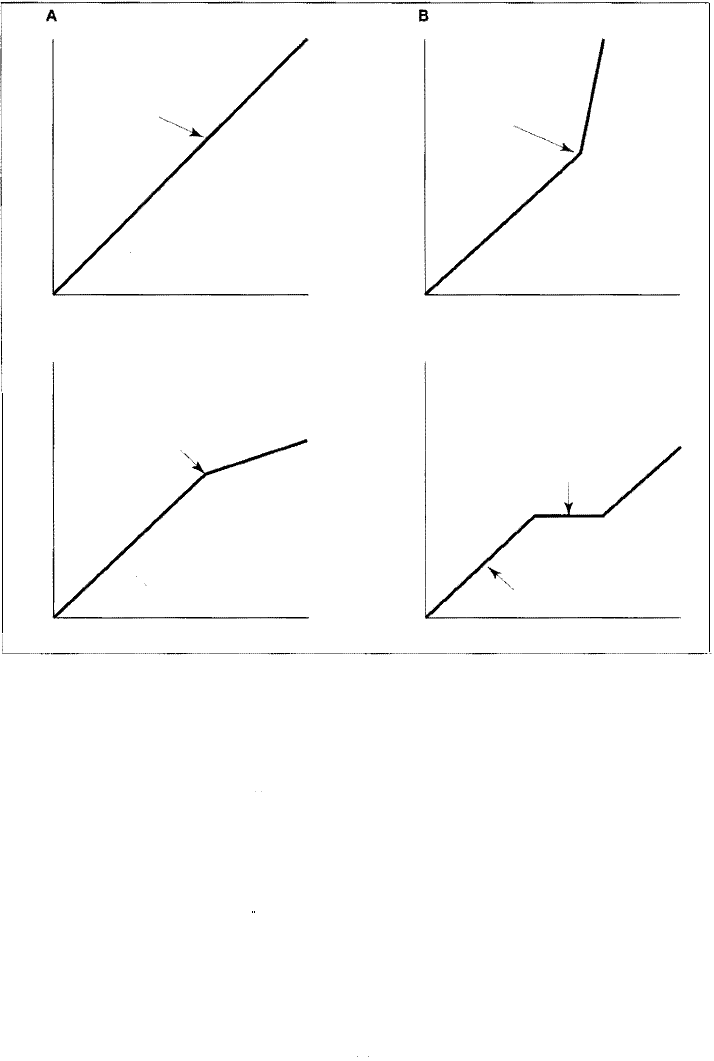
14.7 Biocorrelation
509
A B
t t
<
Uniform
<
Change in
c
sedimentation
c
0
rate
0
sedimentation
n
n
rate
>
>
0 0
!
' Line of correlation
.
*
"· Line of correlation
i
�
�
Meters above base Section B .
Meters above base Section B .
c
D
t
t
<
Change in
<
c c
0
sedimentation
0
�
rate
Hiatus
�
l
l
>
>
0
0
!
l
'
Line of correlation
l
Line of correlation
�
�
Meters above base Section B .
Meters above base Section B .
in the sections. The change in slope in Figure 14.148, for example, indicates a de
crease
in the rate of sedimentation in Section B compared to that in Section A;
Figure 14.14C illustrates a decrease in the rate of sedimentation in Section A. The
presence of a hiatus in deposition in one section shows up as a horizontal line seg
ment in the line of correlation (Fig. 14.140). this example, sedimentation ceased
for a time at Section A while it continued at Section B; then, sedimentation at Sec
tion A resumed. Alternatively, the hiatus might be due to an unconformity or
faulting.
Not only can the graphic correlation method be used for correlating between
any
two local sections, but it also can be expanded by correlating one section after
another to compile a composite section or composite standard (Shaw, 1964; Car
ney and Pierce, 1995). Once a database of composited fossil ranges has been com
piled, this database can be scaled in chronostratigraphic (time) units (Chapter 15).
It is then possible to correlate a particular stratigraphic section against this com
posite standard in the same manner that one stratigraphic section is correlated
against another (Carney and Pierce, 1995). By correlating to a composite standard
scaled in time units, the age of any part of the stratigraphic section can be deter
mined. Graphic correlation is now being used in a variety of applications, includ
ing sequence stratigraphic studies. See Mann and Lane (1995) for detailed
discussion of these various applications.
Correlation by Biogeographical Abundance Biozones
Under
the heading of "Biocorrelation," I discussed correlation by fossil abun
dance biozones and pointed out that abundance zones are unreliable for time
stratigraphic correlation because they are affected by environmental conditions
gure 14.14
Effect of change in sedimen-
tation rate on the shape of
the line of correlation. (A)
Uniform sedimentation rate
in both Section A and
Section B. (B) "Dogleg" in
the line of correlation indi-
cates a relative decrease in
rate of sedimentation in
Section B. (C) "Dogleg" in-
dicates a relative decrease in
rate of sedimentation in
Section A. (D) A hiatus in
deposition in Section A
(caused by nondeposition,
an unconformity, or possibly
fa ulting) shows up as a hori-
zontal segment in the line
of correlation.
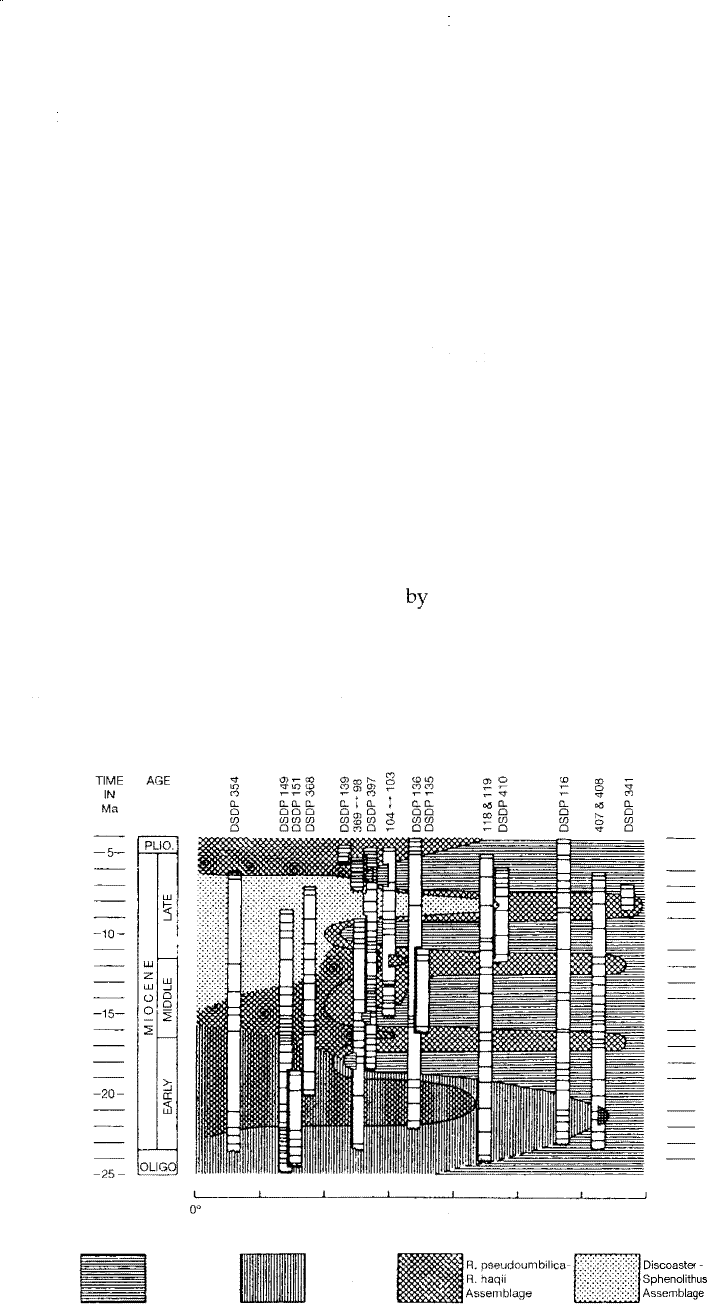
510
Chapter 14 I Biostratigraphy
Figure 14.15
and other factors that can cause them to be diachronous (occur at different times
in different areas). A different approach to the use of abundance zones yields cor
relations that have time-stratigraphic significance; this approach is correlation
based on the maximum abundance of a taxon that results from geographical shifts
of an environmentally sensitive fossil assemblage (Haq and Wo rsley, 1982). Be
cause of latitudinally related temperature dierences in the ocean, some species or
other taxa are restricted to biogeographic provinces that are defined by latitude.
Thus, low-latitude taxa are ecologically excluded from high latudes, and vice
versa; however, changes in climate can allow these taxa to shift into a different bio
geographic province. During major glacial stages, for example, high-latitude taxa
can expand into lower latitudes, and during warming trends between major glacial
stages, low-latitude taxa can expand into higher latitudes. From a geochronological
point of view, the spreading out of certain planktonic species in response to major
climatic fluctuations is essentially isochronous.
Climate-related shifts in planktonic taxa at specific times thus provide bio
geographical abundance events that can be correlated from one area to another.
For each core or outcrop section studied, climatic curves are constructed on the
basis of percentages of warm-climate to cool-climate taxa or relative abundance of
a particular taxon. These curves can then be used to identify episodes of warming
and cooling that can be correlated from one section to another. Figure 14.15, con
structed from this type of information, illustrates how climatically controlled lati
tudinal shifts in calcareous nannoplankton assemblages in the North Atlantic
during Miocene time has been used for chronostratigraphic correlation in Deep
Sea Drilling Program (DSDP) cores.
A related approach is time-stratigraphic correlation based on the coiling ra
tios of planktonic foraminifera, as described Eicher (1976). The multicham
bered shells of some foraminifera are known to coil in one direction when the
species lives in areas of warm water, and in the opposite direction when it lives in
areas of cold water. The foraminifer Globorotalia truncatulinoides, for example, has
dominantly right-handed coils in warm water and left-handed coils in cold water.
TIME
IN
Ma
Use of biogeographical abundance
zones as a means of time correlation.
Cycles of latitudinal shifts of calcare
ous nannoplankton assemblages in
the North Atlantic Ocean during the
Miocene are interpreted as responses
to major fluctuations in climate. The
major shifts of relatively warmer,
midlatitude assemblages into higher
latitudes can be used for the refine
ment of the biochronological scale in
the higher latitudes from which
marker, low-latitude taxa are normal
ly excluded. [From Haq, B. V., and
R. Worsley, 1982, Biochronology
Biologic events in time resolution,
their potential and limitations, in
Odin, G. S. (ed.), Numerical dating
in stratigraphy: john Wiley & Sons,
Ltd., Fig. 4, p. 27. Reprinted by
permission.]
C. pelagicus
Assemblage
10"
20"
30
"
4
0
°
PALEOLATITUDE
C. floridanus
Assem b�age
-5-
-10-
-1 5-
-20-
-25-
5
0
"
6
0
" 70" N
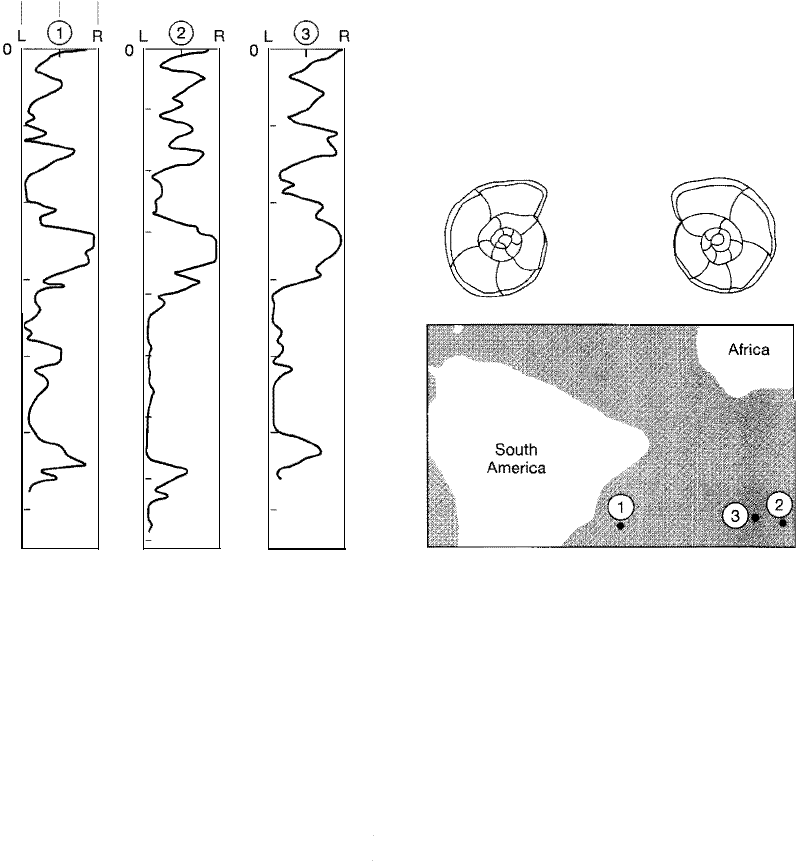
14.7 Biocorrelation
100
100
percent
per
cent
le
r
i
ght
coiling coiling
L
e
c
oili
n
g
Right
c
oili
n
g
100
UmWIIool •l� �
100 100
200
E
200
200
@
Spic� •lew
i)
300
300
300
£
400
E
400
500
400
600
500
500
700
600 600
800
Cor
in
g statio
n
s where the three
c
ores were
obtained
Fire 14.16
Biogeographical abundance zone correlation on the basis of coiling ratios of foraminifers.
Correlation is based on coiling ratios of Globorotalia truncatulinoides in three South Atlantic
Ocean cores. The depositional time represented by the cores is about 1.5 million year.
[A
fter Eicher, D. L, Geologic time, 2nd ed., 1976, Prentice-Hall, Fig. 5.12, p. 115.]
Figure 14.16 shows that during times of glacial cooling of the ocean in the Pleis
tocene, predominantly right-coiled populations of Globorotalia truncatulinoides
were placed in middle and low latitudes by dominantly left-coiled populations.
These changes in coiling ratios of foraminiferal species provide a means of corre
lating short-term uctuations of climatic change in the Pleistocene that are essen
tially synchronous throughout at least a part of an ocean basin.
e major drawback to these correlation meods based on biologic response
to climate fluctuations is at their use is restricted mainly to correlating sediments
deposited during the Quateary and late Tertiary, when several episodes of cool
ing and warming the world ocean took place. Nonetheless, they provide a useful
supplement to correlation methods based on oxygen isotopes (Chapter 15), which
also involve climate fluctuations in the late Tertiary and Quaternary.
511

512
Chapter 14 I Biostratigraphy
FURTHER READING
Berggren, A., D. Kent, M- Aubry, and J. Hardenbol ( eds.),
1995, Geochronology, time scales and global stratigraphic
correlation: SEPM Spec. Pub!. 54, 386 p.
Erwin, D. H., and S. L. Wing (eds.), 2000, Deep time: Paleobiolo
gy's perspective: The Paleontologtical Society, Lawrence,
Kans., 373 p.
Glen, W., 1994, Mass-extinction debates: How science works in a
crisis: Stanford University Press, 370 p.
Hallam, A., and P. B. Wignall, 1997, Mass extinctions and their af
termath: Oxford University Press, Oxford, 320 p.
Jackson, J. B. C., S. Lidgard, and K. McKinney (eds.), 2001, Evo
lutionary patterns: Growth, form, and tempo in the fossil
record, 399 p.
Kemp, T. S., 1999, Fossils and evolution: Oxford University Press,
Oxford, 284 p.
Lawton, J. H., and R. M. May, 1995, Extinction rates: Oxford Uni
versity Press, Oxford, 233 p.
Mann, K. 0., and H. R. Lane (eds.), 1995, Graphic correlation:
SEPM Special Publication 53, 259 p.
Sharpton, L., and P. D. Ward (eds.), 1990, Global catastroph
in Earth history: Ceo!. Soc. America, Spec. Paper 247, 631 p.
Sheldon, P. R., 1996, Plus a change--A model for stasis and evo
lution in different environments: Palaeogeography, Palaeocli
matology, Palaeoecology, v. 127, p. 209-227.
Wa lliser, 0. H. (ed.), 1995, Global events and event stratigraphy
in the Phanerozoic: Springer-Verlag, Berlin, 333 p.

Chronostratigraphy
and Geologic Time
15.1 INTRODUCTION
T
he stratigraphic units described in the preceding chapters are rock units dis
tinguished by lithology, magnetic characteristics, seismic reflection charac
teristics, or fossil content. As such, they are observable or measurable
material reference units that depict the descriptive stratigraphic features of a re
gion. Definition of these units allows the vertical and lateral relationships between
rock units to be recognized and provides a means of correlating the units from one
area to another. As Krumbein and Sloss (1963) point out, however, descriptive
stratigraphic units do not lend themselves to interpretation of the local strati
graphic column in terms of Earth history. To interpret Earth history requires that
stratigraphic units be related to geologic time; that is, the ages of rock units must
be known. Establishing the time relationship among rock units is called
chronostratigraphy, and stratigraphic units defined and delineated on the basis of
time are geologic time units. The relationship between chronostratigraphy and
other branches of stragraphy is illustrated in Figure 15.1.
In this chapter, we examine the concept of geologic time units and explore
the relationship of time units to other types of stratigraphic units. We will also see
how geologic time units are used to create the Geologic Ti me Scale and we will
discuss methods of calibrating the time scale. Finally, we will examine methods
for chronocorrelation-correlation of rock units on the basis of their ages.
15.2 GEOLOGIC TIME UNITS
Geologic time units are conceptual units rather than actual rock units, although
most geologic time units are based on rock units. In fact, we recognize two distinct
types of formal stratigraphic units that can be distinguished by geologic age:
units, called stratotypes, based on actual rock sections, and units independent of
reference
rock sections (see Appendix C)). ldeally, the reference rock bodies for ge
ologic time units are isochronous uts. That is, they are rock units formed ding
the same span of time and everywhere bounded by synchronous surfaces, which
are surfaces on which every point has the same age.
513
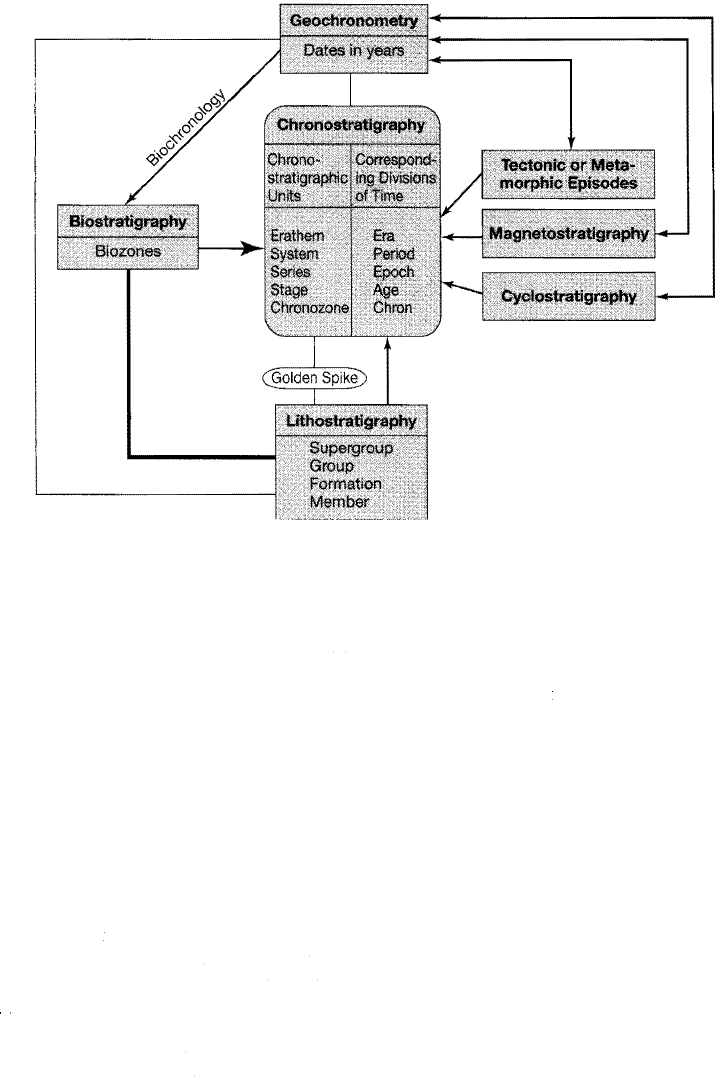
514
Chapter 15 / Chronostratigraphy and Geologic Time
Figure 15.1
Diagram illustrating the proce
dures and processes involved in
chronostratigraphy and the re
lationship of geologic time
units to other kinds of strati
graphic units. Golden spike
refers to internationally agreed
upon points or boundaries in
stratotype stratigraphic sections
selected to serve as reference
sections for chronostratigraphic
units. [After Holland, C. H.,
1998, Chronostratigraphy
(global standard stratigraphy):
A personal perspective, in
Doyle,
P., and M. R. Bennett
(eds.), Unlocking the strati
graphical record: Advances in
modern stratigraphy, joh
n
Wiley & Sons, Chichester,
Fig. 13.1 , p. 384.]
The North American Stratigraphic Code and The Inteational Stratigraphic
Guide (Salvador, 1994) recogze two fundamental types of isochronous geoloc
time units: chronostratigraphic units and geochronologic units. Chronostragraphic
units (Table 15.1) are tangible bodies of rock that are selected by geologists to
serve as reference sections, or material referents, for all rocks formed during the
same interval of time. In other words, a particular section of sedimentary rock
having a known age span is selected to represent that particular interval of geo
logic time. For example, the interval of time from about 275-250 million years ago
is called the Permian Period and is represented by rocks of the Permian System lo
cated in the Province of Perm, Russia (see Ta ble 15.2). Geochronologic units, by
contrast, are divisions of time distinguished on the basis of the rock record as ex
pressed by chronostratigraphic units. They are not in themselves stratigraphic
units. If the distinction between these two types of units seems somewhat confus
ing, the following illustration may help to clarify the difference. Chronostrati
graphic units have been likened to the sand that flows through an hourglass
during a certain period of time. By contrast, corresponding geochronologic units
can be compared to the interval of time during which the sand flows (Hedberg,
1976).
The duration of the flow measures a certain interval of time, such as an
hour, but the sand itself cannot be said to be an hour.
Tr aditional inteationally accepted chronostratigraphic units were previ
ously based primarily on the time spans of lithostratigraphic or biostratigraphic
units. We now also formally recognize (as chronostratigraphic units) polarity
chronostratigraphic units (Appendix C), which are geologic time units based on
the remanent magnetic fields in rocks (Chapter 13).
The characteristics and hierarchical rankings of geologic time units are
briefly described in Table 15.1. Chronostratigraphic units are discussed first in
this table because they are the reference stratigraphic sections upon which time
(geochronologic) units are based. As mentioned, chronostratigraphic units are
themselves based upon designated biostratigraphic, lithostratigraphic, or mag
netopolarity units (Table 15. 1). The fundamental chronostratigraphic unit is the

15.2 Geologic Time Units
515
Chronostratigraphic Unit-an isochronous body of rock that serves as the material reference for all rocks formed
during the same spans of time; it is always based on a material reference unit, or stratotype, which is a biostratigraphic,
liostratigraphic, or magnetopolarity unit
Eonothem-the highest ranking chronostratigraphic unit; the recognized: Phanerozoic, encompassing the
Paleozoic, Mesozoic, and Cenozoic erathems, and the Proterozoic and Arche, which together make up the
Precambrian.
Erathems-subdivisions of an eonothem; none in the Precambrian; the Phanerozoic erathems, names originally
chosen to reflect major changes in the development of life on Earth, are e Paleozoic ("old life"), Mesozoic
("intermediate life"), and Cenozoic ("recent life")
System-e primary chronostratigraphic unit of worldwide major rank (e.g., Permian System, Jurassic
System); can be subdivided into subsystems or grouped into supersystems but most commonly are divided
completely into units of the next lower rank (series)
Series-a subdivision of a system; systems are divided into two to six series (commonly three); generally
take their name from the system by adding the appropriate adjective "Lower," "Middle," or "Upper" to the
system name (e.g., Lower Jurassic Series, Middle Jurassic Series, Upper Jurassic Series); useful for chronos
tratigraphic correlation within provinces; many can be recognized worldwide
Stag-smaller scope and rank than series; very useful for intraregional and intracontinental classifica
tion and correlation; many stages also recognized worldwide; may be subdivided into substages
Chronozone-the smallest chronostratigraphic unit; its boundaries may be independent of those of
ranked stratigraphic units
Geochronologic Unit-a division of time distinguished on the basis of the rock record as expressed by chronostrati
graphic units; not an actual rock unit, but corresponds to the interval of time during which an established chronostrati
graphic unit was deposited or formed; thus, the beginning of a geochronologic unit corresponds to the time of deposi
tion of the bottom of the chronostratigraphic unit upon which it is based and the ending corresponds to the time of
deposition of the top of the reference unit; the hierarchy of geochronologic units and their corresponding geochronos
tratigraphic units are:
Geochronologic Unit
Eon
Era
Period
Epoch
Age
Chron
Corresponding Geochronostratigraphic Unit
Eonothem
Erath em
System
Series
Stage
Chronozone
Geochronometric Units-direct divisions of geologic time with arbitrarily chosen age boundaries; they are not based on
the time span of designated chronostragraphic stratotypes; a geochronometric time scale is commonly used for Pre
cambrian rocks, which cannot be subdivided into globally recognized chronostragraphic units; ages generally ex
pressed millions of years before the present (Ma) but may be expressed also in thousands of years (Ka) or billions of
years (Ga)
ue: No rth American Stratigraphic C and Inteational Stratigraphic Guide (Sdlvador, 1994).
s
y
stem; higher-ranking units are groupings of systems, and lower ranking units
are subdivisions of systems. The ranks of chronostratigraphic units do not corre
spond directly to those of liostratigraphic or other stratigraphic units. A system
of rocks, for example, does not necessarily correspond to a lithostratigraphic
group or a series to a formation. A series might include several formations. In
principle, chronostratigraphic units have worldwide extent and can be recognized
roughout the world. In practice, worldwide use of chronostragraphic its de
pends upon the extent to which the time-diaostic features that characterize
ese units can be recognized worldwide.
Geochronologic units represent the interval of time during which a corre
spondingly ranked chronostratigraphic unit was deposited. The fundamental
geochronologic unit is thus the period-the time equivalent of a system. Names

516 Chapter 15 I Chronostratigraphy and Geologic Time
Ta ble 15.2
e teatio
n
l
y
ac cepted geologic sys tems of
h
e
rozo
an
d
th e Type
localies
System name
Ty pe locality
Name proposed by Date proposed
Remarks
Quaternary
France
Jules Desnoyers
1829
Defined by lithology,
including some unconsoli-
dated sediment
Te rtiary
Italy
Giovanni Arduino
1760 Originally defined by
lithology; redefined with
type section in France on
the basis of distinctive
fossils
Cretaceous
Paris Basin
Omalius d'Halloy
1822
Defined initially on the
basis of strata composed
of distinctive chalk beds
Jurassic Jura Mountains,
Alexander von Humbolt
1795 Defined originally on the
northern Switzerland
basis of lithology
Triassic Southern Germany Frederick von Alberti
1843
Defined lithologically on
the basis of a distinctive
threefold division of
strata; also defined by
fossils
Permian
Province of Perm,
Roderick I. Murchison
1841
Identified by distinctive
Russia
fossils
Pennsylvanian
Pennsylvania,
Henry S. Williams
1891
Not used outside the
United States
United States
Mississippian
Mississippi Va lley,
Alexander Winchell
1870 Not used outside the
United States
United States
Carboniferous
Central England
William Conybeare and
1822 Named for lithologically
William Phillips
distinctive, coal-bearing
strata but recognizable by
distinctive fossils
Devonian
Devonshire,
Roger I. Murchinson
1840
Boundaries based mainly
southern England and Adam Sedgwick
on fossils
Silurian
We stern Wales
Roger I. Murchinson
1835
Defined by lithology and
fossils
Ordovician
We stern Wales
Charles Lapworth
1879
Set up as an intermediate
unit between the
Cambrian and Silurian to
resolve boundary dispute;
boundary defined by
fossils
Cambrian
Western Wa les
Adam Sedgwick
1835 Defined mainly by
lithology
Note: The Precambrian has not yet been divided into internationally accepted systems.
for periods and lower ranked geochronologic units are identical with those for
their corresponding chronostratigraphic units. For example, the Jurassic Period is
the time during which the Jurassic System of rocks was deposited. Periods are di
vided into epochs. Epochs represent the time during which a series was deposited.
They take their name from the period by adding the adjective Early, Middle, and
Late (e.g., Early Jurassic Epoch, Middle Jurassic Epoch, Late Jurassic Epoch). Note
from Ta ble 15.1 the different usage of Lower, Middle, and Upper for subdivision of
